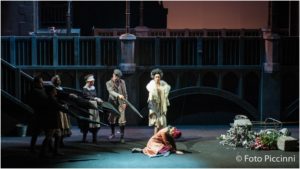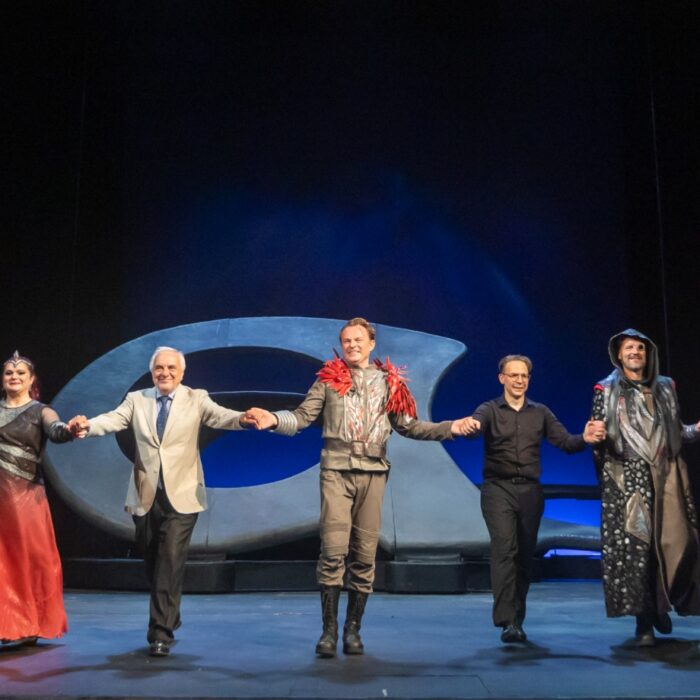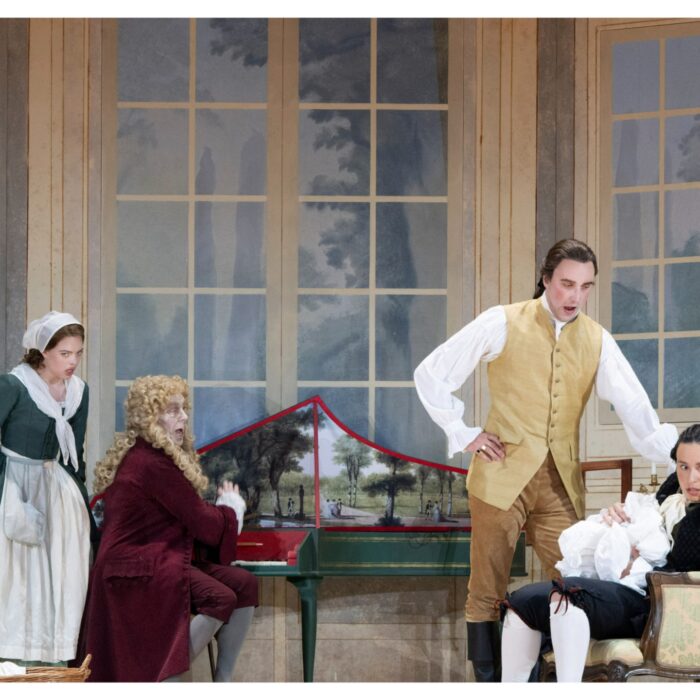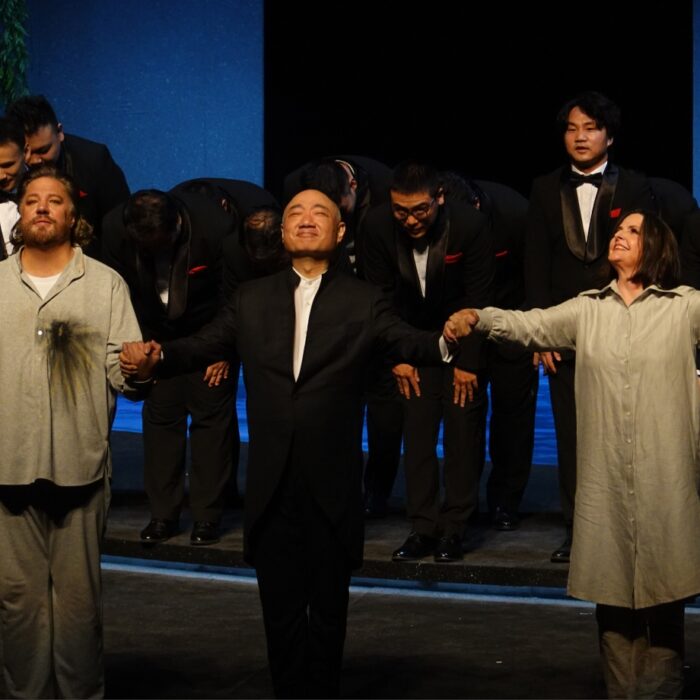
Teatro Comunale di Treviso 2017-18 Review – La Cecchina: Piccini’s Opera Gets Comic Treatment to Sterling Success
By Alan NeilsonBorn in Bari in 1728, the Italian composer Niccolò Piccinni had an established and successful career in both Italy and France, responsible for the composition of more than 80 operas. Although his work is firmly planted in the 18th century and does not stray from the traditional musical forms of the period, his work was widely praised by fellow composers and critics of the day for its dramatic imagination, depth of characterization and, above all, for the elegance and grace of the music. Yet, today his oeuvre has been relegated to a mere footnote, his works rarely, if ever, performed, and interest confined to the cognoscenti and devotees of Italian bel canto or 18th-century music.
Piccinni’s most successful opera, certainly during his lifetime and possibly so today, “La Cecchina ossia La Buona Figliuola,” premiered in 1760, is loosely based on Richardson’s epistolary novel “Pamela,” which concerns the fate of a young girl from an impoverished family, taken in by a rich household to work as a servant. The son of the family, Mr. B., who is in love with Pamela, makes various attempts to seduce and even to rape her, but she always acts in a morally correct and virtuous manner and resists his advances. Eventually, she is rewarded as Mr. B. impressed by her noble and just character, marries her, despite the social gap that exists between them, an act which, at the time, would have brought disgrace upon the family. Carlo Goldoni, Piccinni’s librettist, although admiring its sentiments, was unable to accept the relegation of “family honor” in this manner, and therefore, found it necessary to alter various details: most significantly, the more brutal aspects of the plot are removed, and “La Cecchina” is cast as an orphan, who turns out to be the lost daughter of a German aristocrat so that her marriage into the family is no longer seen as a social disgrace. The story thus ceases to be a critique of societal values in relation to the family, instead becoming a sentimental light-hearted romp.
Sentiment As Key
In fact, the Argentine director, Martin Ruis, identified the work’s sentimental nature as the key feature in the creation for a successful performance. To this end, he moved the drama from the 18th century to the world of early Hollywood films, to a world inhabited by Buster Keaton, the Marx Brothers, and the Keystone Kops – all of whom make numerous appearances in various forms. The protagonists of the opera play out the drama against this backdrop, adopting the exaggerated gestures and mannerisms of the early movies, replete with rapidly fluttering eyelids, slapstick, and heavy make-up. And as per the early movies, everyone and everything was given a sentimental twist, stereotypes replaced reality and nothing was too serious. It all worked exceptionally well and suited the intimate surroundings of Treviso’s Teatro Comunale, “Mario del Monaco,” in which no one is seated too far from the stage so that the finer details of the production were easily visible. Moreover, Ruis deliberately enhanced the connection between the audience and the performers by having the drama spill out into the auditorium; the front of the stalls, the aisles, and the pit being frequently invaded by the cast.
Comedy was never far from the action, and mostly of the type to be found on the silent screen. It was truly marvelous stuff. A couple of standout examples will serve to illustrate. In Act two Tagliaferro leaves the stage and threatens the conductor, Eddi de Nadai, who responds by pulling out a machine gun and shooting him, catching the audience totally by surprise. Throughout the opera Ruis, making a cameo appearance as a hobo, is chased around the theatre (not just the stage) by a couple of Keystone Kops, which he always manages to avoid by some ingenious device, such as masquerading as a table. Even the usherettes became involved!
The set, designed by Massimo Chechetto, comprised of a U.S. cityscape on two levels: a bridge, over which cars and people passed and the arches below in which most of the action took place. It was simple and effective, and pleasing on the eye. It was reminiscent of a scene from the film “Bugsy Malone” and had the same ambiance. There was only one short set change: one scene in Act three took place in an Art Deco cinema, in which the cast and the audience watched snippets from silent movies of the period, which comprised of a montage of slapstick shenanigans which Ruis had also incorporated into the production. The costumes, designed by Carlos Tieppo, were typical of the 1920/30s and added to the overall desired effect.
Having Lots of Fun
The cast, although relatively young and inexperienced, produced a vivacious and thoroughly entertaining and spirited production. All performed well, although not necessarily without fault, and some played their roles to a very high standard indeed!
In the title role of La Cecchina was the soprano, Elisa Verzier. Surprisingly, at the end of the opera, she did not receive the level of sustained applause her performance richly deserved. She delivered a nuanced and beautifully sung Cecchina. Her delightful phrasing was expressive and controlled, exhibiting a rich palette of subtle colors. Technically secure, she displayed a pleasing coloratura and smooth legato. The rendition of the plaintive aria, “Vieni, il mio seno” was sung with great feeling, sensitivity, and pathos, and highlighted the beauty of her voice.
The baritone Lu Yaxiang belied his relative inexperience with a polished acting and singing performance as the German emissary, Tagliaferro, playing the part for all it was worth. Dressed in an army officer’s uniform with pumpernickel helmet, along with a Hitler (or maybe that should be Chaplinesque) mustache, he strutted across the stage with an authoritarian swagger and elicited every last once of comedy from the role, and had the audience laughing out loud with his exaggerated soldiery movements. Yaxiang’s voice has strength and flexibility, with an enticing dark nutty lower register and shining middle register, although he sometimes lost focus in the upper reaches. This was an impressive performance, in which he employed his substantial expressive vocal skills with intelligence to create a very entertaining and boldly drawn character.
As the Marchese della Conchiglia was the Italian tenor, Diego Rossetto. His voice has a pleasing timbre, strong across the range, and both arias and recitatives were sung with confidence. Overall, however, his singing was bluff and lacked variation, especially dynamically so, and although not unattractive, it did compromise his portrayal of the character.
The Marchese’s sister, La Marchesa Lucinda was parted by the Brazilian mezzo-soprano, Luisa Kurtz. Of all the actors she probably acted out the part of a 1920s silent screen star most convincingly, exaggerating her gestures perfectly. She backed this up with a solid vocal performance, displaying secure technique with an attractive coloratura.
The young Italian soprano, Sara Fanin, at only 23, looked every bit the part in the trouser role of Il Cavaliere Armidoro. The role requires a substantial amount of technical skill, especially the bravura aria, “Delle sposa il bel sembiante,” with many coloratura passages, leaps, and trills with a high-lying tessitura as well as an ability to characterize the role without ever compromising the essential bel canto. Fanin gave it a good shot, and while there was much to admire in her singing – timbre, flexibility, coloratura – she was unable to maintain consistency. At times her tone and technique were excellent, at others her voice unraveled in the higher range and the voice became a little harsh and thin.
Michele Soldo made an excellent impression in the not particularly interesting role of Mengotto, the servant. He possesses a rich baritone, with a beautiful timbre, an ability to subtlety characterize the voice, and made the most of the part by producing an engaging and sympathetic reading.
The two maids of the Conchiglia household, Sandrina and Paoluccia, were played by Arianna Cimolin and Jingchao Wu respectively. Acting in tandem for most of the opera, they put in a compelling performance as a couple of interfering minxes. While Cimolin took the opportunity in her aria “Son tenera di pasta” to show off her vocal technique and her voice’s expressive quality, Wu did not do herself justice in one of the scores most delightful arias “Che superbia maledetta,” in which she failed to engage with the necessary emotion, but simply spat out the words, so that it fell flat and failed to make an impression. A pity, as she otherwise performed well.
Balance in the Pit
Under the baton of de Nadai, the Ensemble Benedetto Marcello produced a delightful and refined reading of the score. de Nadai maintained a beautiful balance amongst the ensemble, with only the occasional wayward dynamic blemish from the brass. Although only lightly scored for a relatively small orchestral force, de Nadai elicited some wonderful colorful textures and kept up a brisk pace, overlayed with well-defined dynamic inflections. On the negative side, occasionally the slower sections, especially in the orchestral passages, lacked the necessary reflection and pathos and thus dimmed the contrast. Overall, however, it was a vibrant and engaging reading.
Whilst watching this performance of “La Cecchina,” it was particularly interesting to note how Piccinni foreshadowed, to an extent, the developments in Italian opera over the next 50 years. The quick patter exchanges, so well delivered by Wu and Cimolin throughout the evening, were certainly reminiscent of Rossini, and the structural design of the end of act finales, although on a much smaller and simpler scale, prefigure Mozart’s innovations.
Hats off, therefore, to Treviso’s Teatro Comunale and its young and enthusiastic cast, not only for having the courage to stage a relatively unknown work by a largely ignored composer, but to do so to such a high standard and with such imagination and skill, that it kept the audience thoroughly engrossed and entertained throughout the evening.


